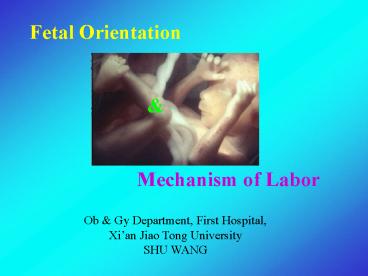Fetal Orientation PowerPoint PPT Presentation
1 / 32
Title: Fetal Orientation
1
Fetal Orientation
Mechanism of Labor
Ob Gy Department, First Hospital, Xian Jiao
Tong University SHU WANG
2
Fetal Orientation
- Fetal lie
- Fetal presentation
- Fetal position
3
Fetal lie
- Refers to the relationship of the long axis of
the fetus to the long axis of the mother - Longitudinal 99 of all fetuses assume this lie.
- Transverse long axis of the fetus is
perpendicular to the long axis of the mother. - Result of over-relaxation of maternal abdominal
wall - Increased risk with multiple pregnancies
- Requires a C-section
- Oblique the relationship of the spines forms lt45
degree angle.
4
Fetal lie
Oblique
Longitudinal
Transverse
5
Fetal presentation
- Presenting part
- Refers to the part of the fetus that enters the
canal first - Cephalic
- Vertex head with chin flexed toward chest (most
common cephalic position) - Face fetuss neck is hyperextended bringing the
back of its head - Breech 3 presentations
- Shoulder
- Compound
6
Cephalic presentation
Vertex presentation
face presentation
7
Breech presentation
- Frank breech (50-70) - Hips flexed, knees
extended (pike position) - Complete breech (5-10) - Hips flexed, knees
flexed (cannonball) - Footling or incomplete (10-30) - One or both
hips extended, foot presenting
8
Shoulder presentation
Compound presentation
9
Normal presentation
Abnormal presentations
10
Fetal position
- Determines the relationship of a designated point
of the presenting part in relation to the
maternal pelvis
Presentation Point of reference
Vertex Occiput
Face Chin (Mentum)
Breech Sacrum
Shoulder Scapula
11
Fetal position
- Designated points used for the maternal pelvis
follow
Left Occipital Anterior
Right Occipital Anterior
Anterior
Right
Left
posterior
Right Occipital Posterior
Left Occipital Posterior
- LOA fetal head is presenting with occiput
directed toward the left side and anterior pelvis
of the woman
12
Occiput position
Left
Transverse
Right
Left Occiput Anterior LOP
Left Occiput Transverse LOT
Left Occiput Posterior LOP
13
Mentum position
Left Mentum Anterior LMA
Left Mentum Posterior LMP
14
Mechanism of Labor
The sequencing of events related to
posturing and positioning that allows the baby to
find the "easiest way out."
Mechanism of labor a series of passive, adaptive
movements of the fetal head and shoulders
smallest diameter to pass through the birth canal
15
Review Pelvis
A-P d 11cm
Oblique d.12.75cm
Transverse d13cm
midpelvis
A-P d
A-P d.11.5cm
Transverse d.9cm
Transverse d10cm
16
Review Axis of Pelvis
17
Review Fetal cranium
18
Review Fetal cranium
19
Fetus makes his head smaller
flexion
gt
Occipitofrontal diameter
Suboccipitobregmatic diameter
20
Mechanism of Labor
- Positional movements the fetus undergoes to
accommodate itself through the maternal pelvis
Engagement Descent Flexion Internal rotation
Birth of the shoulders External
rotation Restitution Extension
21
Engagement
Occurs when the fetal presenting part has passed
through the maternal inlet of the pelvis
22
Descent
continuous downward movement of fetus through
birth canal
1. pressure by the amniotic fluid 2. direct
pressure by the contracting fundus on the
fetus 3. force of the contraction of the maternal
diaphragm and abdominal muscles in second stage
labor 4. extension and straightening of the fetal
body
23
Flexion
shape of the uterus causes fetal neck to flex and
the chin rests on its chest
- Allows the smallest diameter of the head to
pass through the smallest portion of the maternal
inlet
24
Internal rotation
- Allows fetal head to pass beneath the pelvic arch
rotation from a diagonal or transverse position
to an anteroposterior position
25
Extension
- Fetal head extends to allow the birth of the
occiput, face, and chin - Occurs in response to the pressure from uterine
contractions and shape of pelvic floor
26
Restitution and external rotation
- After head is delivered, it immediately rotates
to the left or right - Assumes previous position that it was in during
engagement - Anterior shoulder is delivered first followed by
the posterior shoulder
27
Expulsion
Once shoulders are delivered, rest of the body
just slides out
28
Critical Movements of labor
29
- No two pelvis are exactly the same, just
as no two faces are the same. For each pelvis
there is an optimum mechanism that may be wholly
different from the so-called normal mechanism.
-------Caldwell and Maloy
30
The end!
31
Picture
- These children wish they could go home to a nice
family but they have no home to go to everyday
is a misery.
32
Fantasies Can Come True
- Lets make these childrens fantasies a reality.

